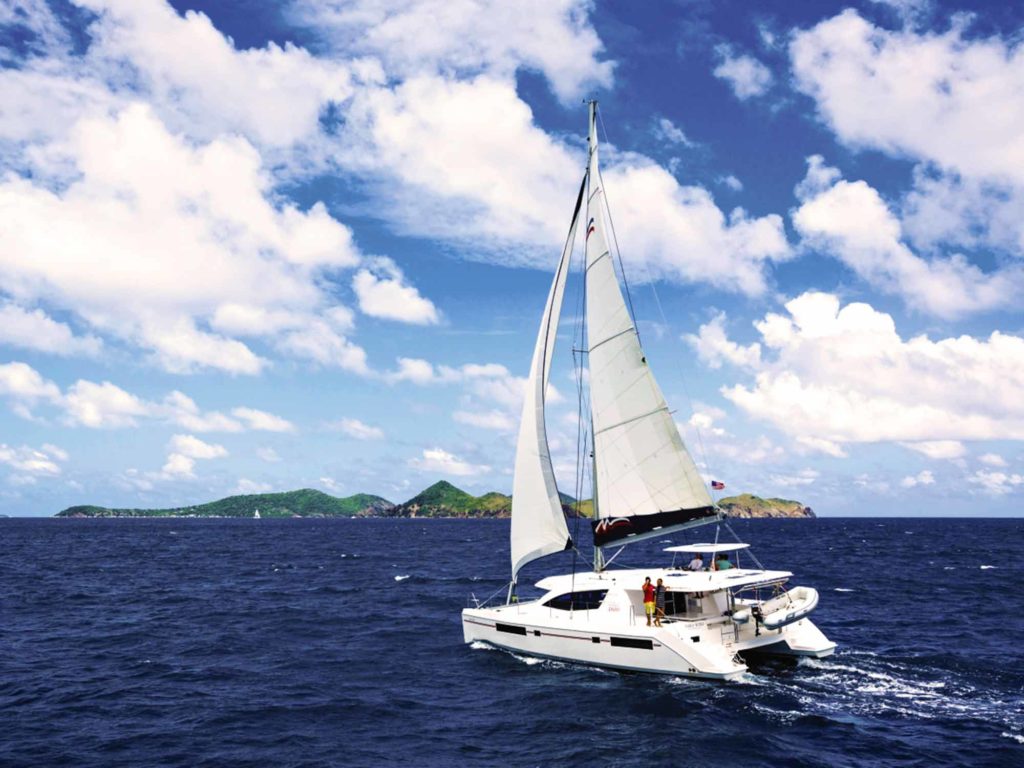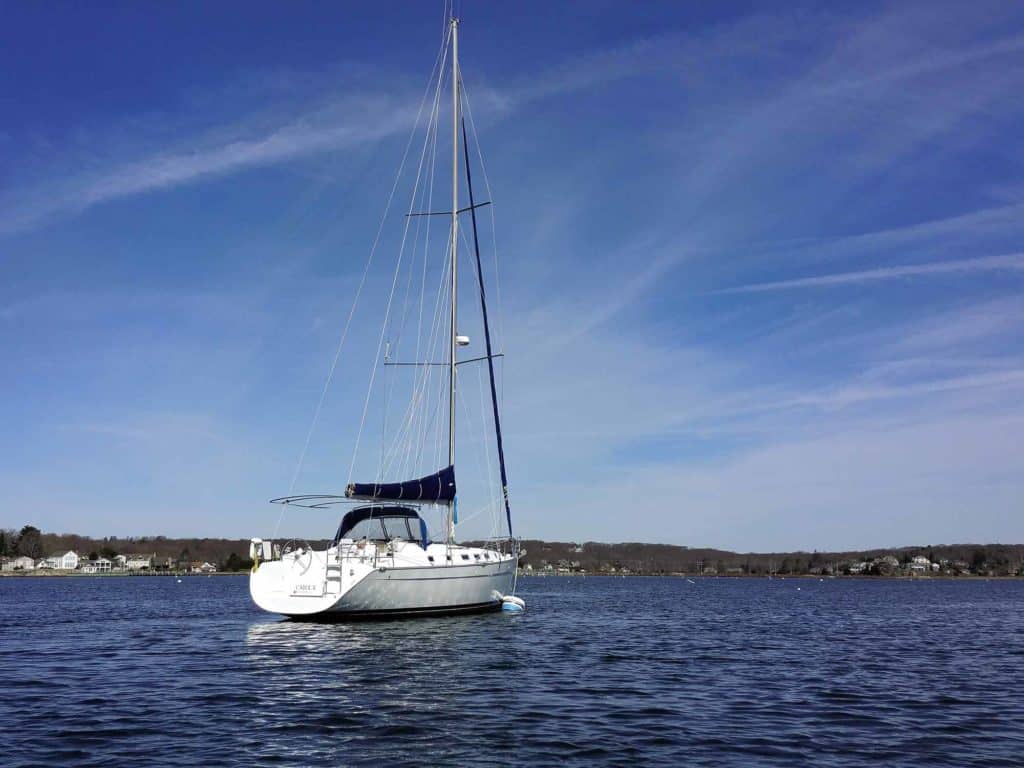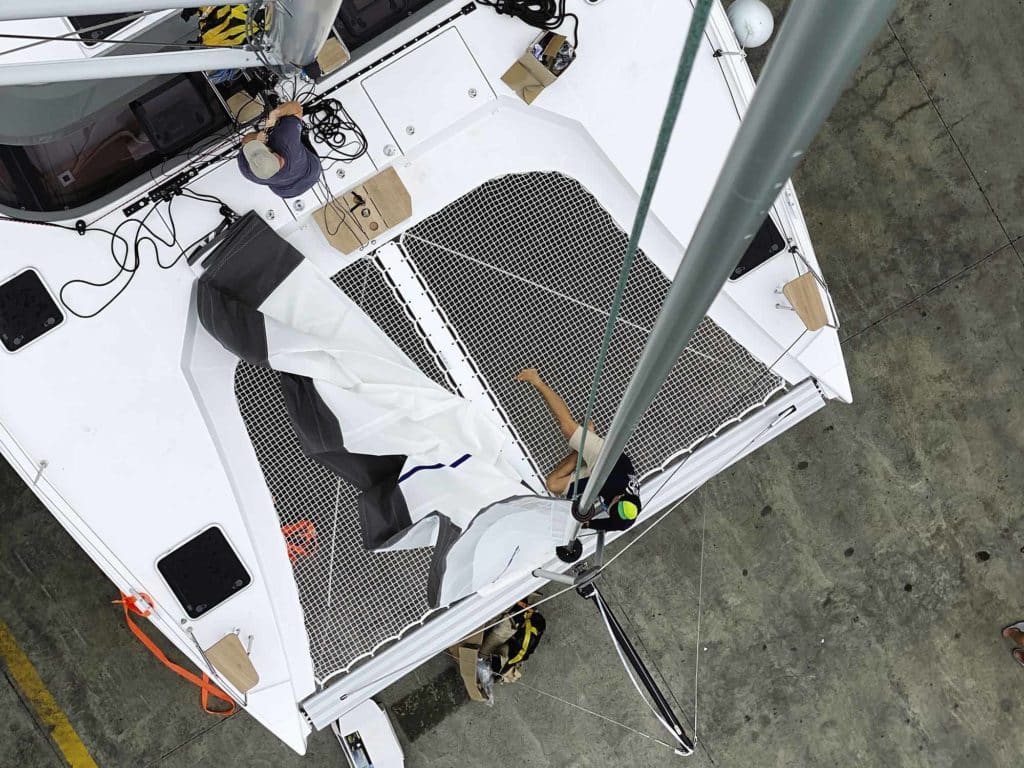
One summer, while living on our sailboat in Wickford, Rhode Island, I was invited for sundowners aboard Carol K, a Beneteau Cyclades 43, whose owners, Carol and Peter King, had stopped for the night during a summer getaway from their home waters of Noank, Connecticut, on Long Island Sound.
The Kings are avid sailors, and at the time organized CW’s Adventure Charters, a series of flotillas to exotic sailing locations around the world. They always have great stories to tell, and I looked forward to seeing their boat, which had recently finished service with the Moorings fleet in Tortola, in the British Virgin Islands.
Motoring over, Carol K was immediately identifiable because, well, even without company graphics, she looked like a charter boat—sort of. There was a colored UV strip on the headsail furled on the bow, a blue sail pouch on the boom and a square floating Bimini over the cockpit, which at the time was quite popular with the charter fleet. But climbing aboard, it became quickly apparent this was no bareboat rental. From stem to stern, and especially down below, the Kings had added touches that made it abundantly clear that Carol K was their home on the water.
The Kings had owned two boats with the Moorings, each in service as a charter boat for five years. When their first contract expired, Peter says they decided to buy a second boat to put into the fleet. From the get-go, they planned to augment the monthly payments they received from the company to pay down the mortgage more quickly, and to keep the boat when its charter life came to an end. He notes that charter-boat owners are well-advised to have a plan in place for what to do with their vessel at the end of its charter contract. You don’t want to “get snookered,” he says, and end up with no economically sensible option.
During its charter years, Peter says he and his wife made a pact that if they saw the boat, they wouldn’t obsess about scrapes and scratches— they were out of the couple’s control and could be fixed during phase-out, the period when the charter company goes through the boat before either turning it over to the owner or selling it for them on the brokerage market.
Peter says that on average, their boat was in service about 18 weeks a year. And while he admits he had concerns about the number of engine hours racked up by vacationers, a properly maintained diesel has longevity. And in the end, they were happy with both the monthly payments and the maintenance plans the Moorings follows.

When it came time to take possession of the boat, the company replaced the table and refinished the sole. And then, Peter hired a surveyor to go through the boat and do a complete inspection. When the report came back, a few problems were identified, including worn turnbuckles, which were replaced. When all the work was complete, he had a second survey done, and then, on Boxing Day 2009, he and Carol left Tortola and spent the next four months sailing home to Noank.
Before leaving, the Kings installed a radar, a better plotter and a Flexofold propeller. And over time, Peter says they replaced two of the three manual heads with electric ones and removed a third to create a larger shower. Outside of that work and regular maintenance, they had no problems with the boat.
“I think it’s a pretty good deal,” Peter says when asked about buying and owning a used charter boat. Boats are often listed for thousands of dollars less than a similar model in private ownership, and a buyer can bargain hard because the charter companies need to routinely refresh their fleets. “You can get a good boat for a good price if you’re cautious and don’t get carried away,” he says.
Franck Bauguil, vice president, yacht ownership, for the Moorings and Sunsail, says his brokerage operation sells between 120 and 150 used monohulls and catamarans a year. And while these boats are not for everyone—layouts are optimized for chartering, and often the vessel will need to be picked up at the base or else there could be significant delivery costs for hiring a captain and crew—the boats have been professionally maintained and are kept in good working order.
Typically boats in the Caribbean see five peak seasons before they are phased out; in Europe, where the sailing season is shorter, and in exotic locations, where demand is less, they are typically replaced after six years. Both brands have created detailed maintenance manuals that prescribe regular service intervals.
Between trips, vessels get a general inspection, and any problems are fixed for the next guests. Quarterly, they see a more comprehensive examination. Semiannually, systems and engines are gone over, and once a year, the boats are hauled, new anti-fouling is applied, and any needed overhaul or replacement takes place.
Because boats need to be ready for quick turnarounds, Travelopia, parent company to the two brands, carries $1 million to $2 million in parts inventory so repairs won’t be delayed. “Our intent,” he says, “is to keep the boats in the best possible condition.”
Bauguil estimates that most monohulls will see their builder-supplied sails replaced at least once during their five working years. Catamarans are handled a little differently because their sails are spec’d out by Travelopia and are built for heavy-duty service.

The key, Bauguil says, is to have a thorough survey of the boat and systems.
Bottom line: While the boats see a lot of use, inspections are scheduled and any repairs are done by professional mechanics, composite specialists, electricians, etc. The same can’t always be said for private-owner boats, where the skipper might or might not know what he’s doing, Bauguil says.
A buyer looking at a used charter boat should compare the price differential for a similar privately owned model, and then factor into the budget cosmetics and other upgrades. Even big jobs, such as installing a new engine, might not be a deal- breaker when you look at the difference in price.
Andrew Thompson at Horizon Yacht Charters, another company with multiple Caribbean bases, including Nanny Cay in Tortola, and a large fleet of monohulls and catamarans, also emphasizes maintenance as part of the value proposition offered with used charter boats. A diver checks the bottom of every boat when it returns to the base to see if the boat was grounded or otherwise damaged. And customers are debriefed and asked about anything not working. Customers’ sailing resumes are carefully checked, and taking a captain is encouraged in some cases.
Most charter companies don’t actually own the boats they rent out, so maintenance and repairs are done to meet the expectation of the actual owners.
Thompson cites a comprehensive preventative- maintenance program that was created for owners with boats in the fleet and also those under private management, another side of Horizon’s business. It includes routine inspection of mechanical systems, rigging and the like, and annual deeper evaluations during the slow season. The result is relatively few insurance claims and clean survey reports when yachts reach the end of their working life.
For those hunting for a catamaran to make their escape, Horizon’s used inventory of smaller models—say under 42 feet or so—might be of interest because they include boats with both three- and four-cabin layouts. The former are preferred by most private owners, but many charter companies prefer to offer four- berth boats that can bring in more revenue. And larger yachts are nearly all configured with four cabins.
Thompson notes that when looking at used boats at online sites such as yachtworld.com, buyers might be faced with wild variations in price, depending on how an owner or company may have spec’d out a boat and how it’s been maintained and cleaned up during phase-out. Some European companies, for instance, offer boats with only minimal equipment, while in the Caribbean, a similar boat might be loaded with electronics and upgrades.
Patrick O’Loughlin, the owner of St. Kitts Nevis Surveying & Consultancy who also works for Jocelyn Maritime Training and Consultants in Tortola, has inspected charter vessels throughout the islands. He notes that most charter companies don’t actually own the boats they rent out, so maintenance and repairs are done to meet the expectation of the actual owners.
“What you do expect is more wear and tear, but what you can say, if you buy a charter boat, is it’s been well-tested. Given that most of these boats are fiberglass, they can be repaired,” he says.
When he’s representing an owner during a phase-out inspection, besides the integrity of the hull and major systems, he notes little things such as torn curtains and scratched woodwork. Owners should expect these to be corrected by the charter company before the boat is released.
He too stresses the importance of a thorough survey. “As the surveyor, I can’t really tell you in the final analysis whether to buy or not to buy—that’s not my job. But I point out all the little things I see that are not in keeping, not in sync.” And it’s those little things that are reflected in the value he puts on the boat. A potential buyer, he says, does well to heed that figure because it reflects how a particular boat measures up compared with others on the market. With a survey in hand, buyers can then make an offer based on their willingness to make repairs or live with dings and dents. When looking at charter boats, his checklist includes any cracks around the keel, evidence of a dismasting, water damage to the sole or furniture that would indicate a leak or sinking, and the engine and other systems. If he spots a problem, he then starts asking around the waterfront to see if there are any stories among the local captains that might explain the damage.
So is a used charter boat worth the look? We’ll give the Kings the final say on that one. Asked about their years owning Carol K, Peter says, “It was fun owning it.” And Carol shouts over him on the phone: “We miss it. We miss it a lot.”
Mark Pillsbury is a CW editor-at-large.








